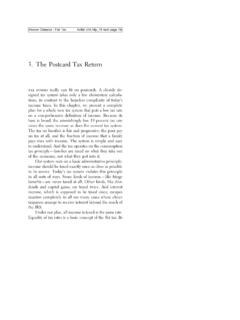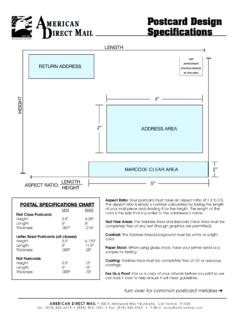Transcription of Stadium and Sports Postcard Collecting - Old …
1 Stadium and Sports Postcard Collecting Yankee Stadium , Ebbets, Forbes and Cleveland Municipal By George Vrechek with Ray Medeiros The Sports collector has many ways of Collecting memorabilia. Many of us started Collecting baseball cards as youngsters. If we were enthralled about the players and the game, we may have morphed into collectors of autographs, uniforms, baseballs, or equipment. If we really liked the smell of the cardboard and the neatness of players, teams, and numbers organized in a box, we may have continued with regular baseball cards but branched into older or newer cards as well as football, basketball, hockey, and other Sports . Distant Cousins and Jefferson Burdick postcards have seemed to me to be distant cousins of the gum or insert Sports cards. I don t recall seeing any postcards of players as a kid.
2 Nothing came to mind that looked like a baseball card with stats on the back, plus postcards wouldn t have fit neatly into the boxes containing Topps and Bowmans. I have been to a few Postcard shows; they were certainly low-key events. Postcard collectors didn t look like big Sports fans to me. They were patient folks though, pouring through stacks of cards ranging from the Wisconsin Dells to Niagara Falls. However the father of card Collecting , Jefferson Burdick, waxed eloquently about the beauty of the Postcard even creating a few of his own featuring snowy scenes he had photographed in his home town of Syracuse. Burdick devoted eight pages of explanatory text to cover postcards versus one page for insert cards (all tobacco cards) in his 1960 American Card Catalog. Burdick s card identification system placed Sports postcards starting at PC740 and going through PC798.
3 Burdick also wrote books on just postcards . He edited the The Handbook of Detroit Publishing Co. postcards , 1954 and Pioneer Post Cards; 1957. Not knowing much about postcards , I figured Pioneer Post Cards must have been about the pioneers. At any rate, if Burdick was enthused about postcards , maybe I should give them another look but limit myself to Sports postcards . Ray Medeiros, Sports Postcard Collector Hobby pioneers Burdick, Buck Barker, and Walt Corson knew a thing or two about Sports postcards , but all have been dead for at least 28 years. Fortunately one of Buck Barker s prot g s, Ray Medeiros, is very much around. I interviewed Ray (September 17, 2010 SCD) and covered his collection of baseball history including photographs and newspaper clippings. I also touched on his extensive collection of Stadium postcards .
4 Ray was delighted to provide more insight into Sports Postcard Collecting . Ray has been Collecting baseball Stadium postcards for 62 years. US Postal Regulations and the History of postcards The Postal Service has always been a rather humorless group when it comes to postal regulations. You can get yourself in a fair amount of hot water by sticking something in a resident s mailbox without sending it through the official Postal Service. Fraud through the mail seems to be more punishable than if you used a loud speaker. Writing a note over on the address side of the Postcard is also verboten. It is no wonder that in the late 1800s the Postal Service was concerned about businesses advertising through the mail by sending advertising cards to residents on the cheap, the earliest form of junk mail.
5 Consequently the Postal Service did not allow any private picture postcards . You could only use a government Postcard which was extremely boring. The government issued card was blank on one side for your message. The address and stamp went on the other side, no fancy sizes or colors allowed either. Cards were issued by the Postal Service starting in 1873 which started the Pioneer era of postcards that Jefferson Burdick covered in his book. Burdick mentions Pioneer Post Cards in the text of his American Card Catalog. He writes that the book is out of print (in 1960) but that 800 copies can be found in libraries. His book covered the origin and early development of the picture post card, I would imagine, in succinct but vivid detail as was his style. The 1893 World s Columbian Exposition was an occasion for the Postal Service to lighten up and allow picture postcards produced by others to be sent from the exposition grounds.
6 The idea was such a hit that the Postal Service went back to prohibiting picture postcards again right after the event. Europeans had no such problem with picture postcards and the Postal Service realized that they could actually make more money, if they allowed the use of cards. In 1898 the Postal Service allowed private mailing cards. In 1902 they allowed picture post cards but you could only write the address on the blank side; any message had to be on the front of the card with the picture. Many people just wrote over or around the picture to tell the folks at home that they were, in fact, at Niagara Falls as pictured. Even with the restrictions, picture postcards were a big hit. (As post cards became more popular, they became postcards , a typical language evolution.) Divided Backs, What a Concept!
7 By 1907, the Postal Service decided that the world would not end, if they allowed Postcard producers to divide the blank back of the Postcard in two so that an address could be placed on the right side and a message on the left. The public thought this was a great idea and started sending, saving, and Collecting picture postcards by the bushel. Burdick wrote that the entire world was in a Postcard Collecting frenzy ( the most raging hobby of all time ) from about 1904 to 1914. Many of the collections assembled in that era are still working their way to other collectors. Earliest postmarked card showing (barely) a major league Stadium in the background Exposition Park, Pittsburg, 1903. Note the single sided back as required by regulations at the time and writing on the front Player postcards from the Pre-Linen Era When I thumb through the SCD Standard Catalog of Baseball Cards to look for postcards with baseball players, I find prices that exceed the cost of my first car.
8 Set names include 1905 Giants Scorecard postcards , 1905 Souvenir Post Card Shop of Cleveland, 1905 Rotograph postcards , and 1906 Ullman postcards . Nearly all of these were issues involving one or two teams. Players continued to appear on Postcard issues associated with teams 1907-9 Dietsche Chicago Cubs and Detroit Tigers, 1907 Grignon Chicago Cubs, Boston Daily American 1912, Max Stein /United States Publishing House 1909-1916, and Sporting News 1915. The Rose Company issue of 1908-9 featured over 200 players and was the closest in postcards to the T206 set of the same era. The message on this 1911 split-backed card is that the Polo Grounds as pictured had burned down a few days earlier. This golden age of early postcards was known as the pre-linen era in that the fuzzier linen cards didn t appear until about 1930.
9 In general, collectors identify Sports postcards by the terms: pre-linen, linen, and chrome. Images could be colored photographs, renderings, or what were known as real photos created by developing the photos directly onto postcards . The only problem with the baseball player cards like those created by The Rose Company is that commons are listed in the SCD Catalog at $2,400 in near mint. Wagner and Cobb are $24,000 each, which exceeds the cost of my current car. Nonetheless there are serious collectors of such early Postcard issues, spending some serious money. Former SCD contributing writer and collector Dan Even is one of the advanced player Postcard collectors as is Bob Thing. Old Ballparks However, if your interest is in the old ballparks rather than the old players, you can collect quite a bit before having to sell your old car.
10 Ray Medeiros has been one of those collectors. Ray contacted Buck Barker in 1948 as a result of Barker s article in The Sports Exchange Trading Post. Buck sent Ray a response using an old Postcard of Sportsman s Park in St. Louis. Ray was quickly hooked on starting a collection, and has picked up 10,233 more Stadium postcards since. While Ray doesn t have all the baseball Stadium postcards in captivity, he probably has 90% of them. My math computes that there have been, on average, 100 postcards issued per year over the 100 plus years that postcards have existed. That comes to only 6 cards per team prior to expansion. For some reason some of the old ballparks proved to be more photogenic than others. For example, Griffith Stadium in Washington was rarely featured on a Postcard . If you went to Washington, you were probably writing home about seeing something other than the Senators play.









